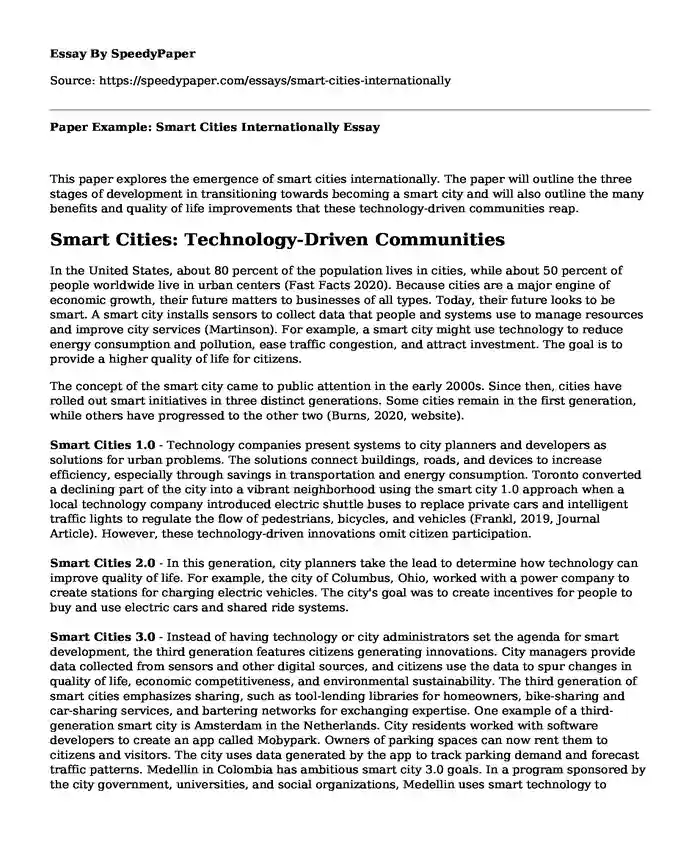
| Type of paper: | Critical thinking |
| Categories: | Engineering Information technologies Community Sustainable development |
| Pages: | 3 |
| Wordcount: | 770 words |
This paper explores the emergence of smart cities internationally. The paper will outline the three stages of development in transitioning towards becoming a smart city and will also outline the many benefits and quality of life improvements that these technology-driven communities reap.
Smart Cities: Technology-Driven Communities
In the United States, about 80 percent of the population lives in cities, while about 50 percent of people worldwide live in urban centers (Fast Facts 2020). Because cities are a major engine of economic growth, their future matters to businesses of all types. Today, their future looks to be smart. A smart city installs sensors to collect data that people and systems use to manage resources and improve city services (Martinson). For example, a smart city might use technology to reduce energy consumption and pollution, ease traffic congestion, and attract investment. The goal is to provide a higher quality of life for citizens.
The concept of the smart city came to public attention in the early 2000s. Since then, cities have rolled out smart initiatives in three distinct generations. Some cities remain in the first generation, while others have progressed to the other two (Burns, 2020, website).
Smart Cities 1.0 - Technology companies present systems to city planners and developers as solutions for urban problems. The solutions connect buildings, roads, and devices to increase efficiency, especially through savings in transportation and energy consumption. Toronto converted a declining part of the city into a vibrant neighborhood using the smart city 1.0 approach when a local technology company introduced electric shuttle buses to replace private cars and intelligent traffic lights to regulate the flow of pedestrians, bicycles, and vehicles (Frankl, 2019, Journal Article). However, these technology-driven innovations omit citizen participation.
Smart Cities 2.0 - In this generation, city planners take the lead to determine how technology can improve quality of life. For example, the city of Columbus, Ohio, worked with a power company to create stations for charging electric vehicles. The city's goal was to create incentives for people to buy and use electric cars and shared ride systems.
Smart Cities 3.0 - Instead of having technology or city administrators set the agenda for smart development, the third generation features citizens generating innovations. City managers provide data collected from sensors and other digital sources, and citizens use the data to spur changes in quality of life, economic competitiveness, and environmental sustainability. The third generation of smart cities emphasizes sharing, such as tool-lending libraries for homeowners, bike-sharing and car-sharing services, and bartering networks for exchanging expertise. One example of a third-generation smart city is Amsterdam in the Netherlands. City residents worked with software developers to create an app called Mobypark. Owners of parking spaces can now rent them to citizens and visitors. The city uses data generated by the app to track parking demand and forecast traffic patterns. Medellin in Colombia has ambitious smart city 3.0 goals. In a program sponsored by the city government, universities, and social organizations, Medellin uses smart technology to exchange information with its citizens. Goals include reducing inequities and promoting cooperation. The city provides Internet and Wi-Fi connections so residents can access government, health, and educational resources. In turn, citizens suggest improvements to basic services, react to initiatives and propose ideas and solutions. Once one of the most violent cities in the world, Medellin has watched its homicide rate drop 80 percent since 2007. For businesses, one of the benefits of smart cities is smart workplaces. Data-gathering sensors can communicate with smart devices to make offices more comfortable and conducive to productivity.
Smart offices are also more secure and efficient for employees, vendors, and customers (Martison, 2021, p.32). Because smart cities focus on sustainability, businesses in smart cities also participate in energy conservation efforts. As a result, they reduce costs and incur the favor of customers, who increasingly consider a company's record on environmental and social change in their purchasing decisions. As centers of innovation, smart cities attract innovators, members of the creative workforce that can transform organizations and encourage economic growth. Businesses depend on these talented employees.
Finally, smart cities are important to business because cities are important to the economy. As urban centers continue to expand, they can suffer from the strains of the additional population through increased crime, poverty, traffic, and congestion. Smart cities offer an alternate, more sustainable way to grow and prosper.
References
Burns, S. (2020, 2 May). Brief History of Smart Cities. Website
Frankl, R. (2019). City as Network. Urban Planning. Journal Article
Kaya, G. (2020, 5 November). Fast Facts: 2020: Demographics. Retrieved from http: //www.mr.cengage.com
Martison, C.B. (2021, 15 February). Three eras of Smart City Development, Urban Anthropology. pp. 32-34
Ortiz, E. (2020). Transformations in South American Cities. Municipal Innovations. pp 14-16.
Cite this page
Paper Example: Smart Cities Internationally. (2023, May 02). Retrieved from https://speedypaper.com/essays/smart-cities-internationally
Request Removal
If you are the original author of this essay and no longer wish to have it published on the SpeedyPaper website, please click below to request its removal:
- Gentrification and the Minority Neighborhood Research. Free Essay.
- Free Essay on Effects of Depression on Our Bodies
- Essay Sample for Everyone: Radio Broadcasting in Spain during Francos Regime
- Strait of Georgia Conservation Initiative - Essay Sample for Everyone
- Essay Sample on Stars and Star Clusters
- Free Essay: Usage of Illegal Substances by Adolescents Who Have Mental Health Diagnosis
- Climate Change Impact on Health in Tijuana: Exploring Vulnerabilities and Injustice - Free Essay
Popular categories




